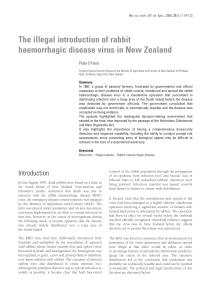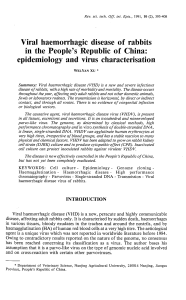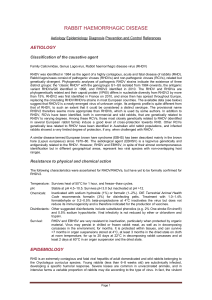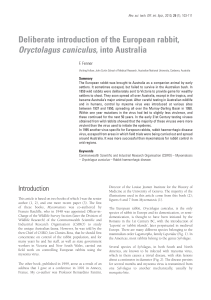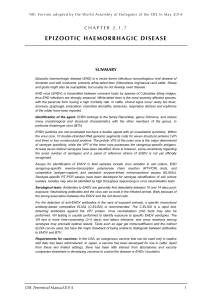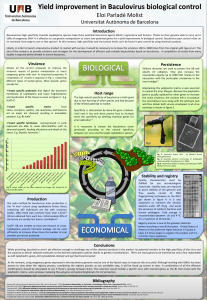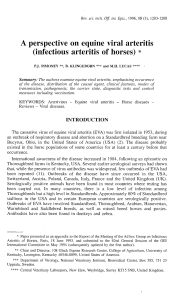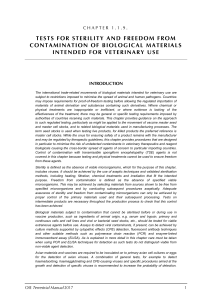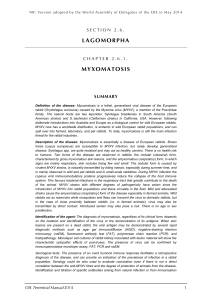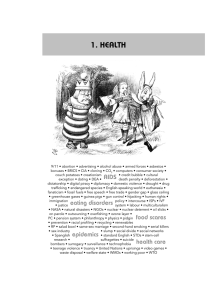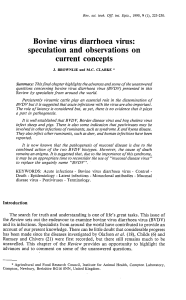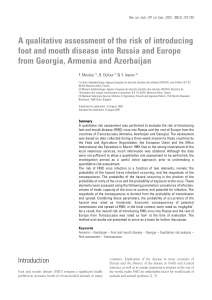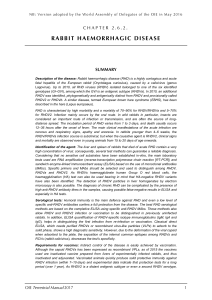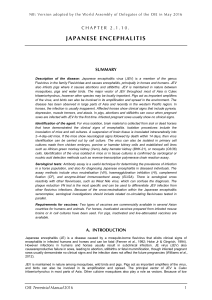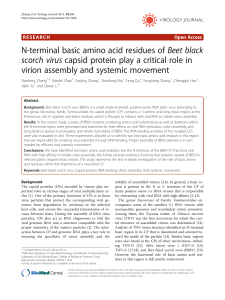Adaptation of the viral haemorrhagic disease virus of rabbits to the
publicité
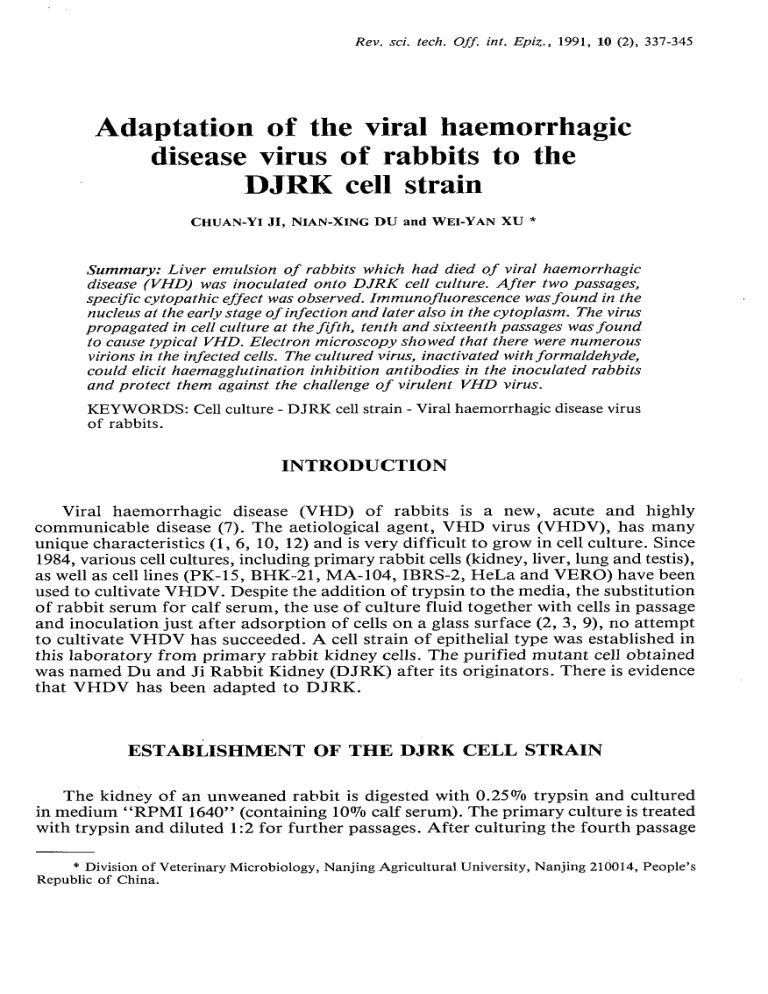
Rev. sci. tech. Off. int. Epiz., 1991, 10 (2), 337-345 Adaptation of the viral haemorrhagic disease virus of rabbits to the DJRK cell strain CHUAN-YI JI, NIAN-XING D U and WEI-YAN X U * Summary: Liver emulsion of rabbits which had died of viral haemorrhagic disease (VHD) was inoculated onto DJRK cell culture. After two passages, specific cytopathic effect was observed. Immunofluorescence was found in the nucleus at the early stage of infection and later also in the cytoplasm. The virus propagated in cell culture at the fifth, tenth and sixteenth passages was found to cause typical VHD. Electron microscopy showed that there were numerous virions in the infected cells. The cultured virus, inactivated with formaldehyde, could elicit haemagglutination inhibition antibodies in the inoculated rabbits and protect them against the challenge of virulent VHD virus. KEYWORDS: Cell culture - DJRK cell strain - Viral haemorrhagic disease virus of rabbits. INTRODUCTION Viral haemorrhagic disease (VHD) of rabbits is a new, acute and highly communicable disease (7). The aetiological agent, V H D virus (VHDV), has many unique characteristics ( 1 , 6, 10, 12) and is very difficult to grow in cell culture. Since 1984, various cell cultures, including primary rabbit cells (kidney, liver, lung and testis), as well as cell lines (PK-15, BHK-21, MA-104, IBRS-2, H e L a and V E R O ) have been used to cultivate V H D V . Despite the addition of trypsin to the media, the substitution of rabbit serum for calf serum, the use of culture fluid together with cells in passage and inoculation just after adsorption of cells on a glass surface (2, 3, 9), n o attempt to cultivate V H D V has succeeded. A cell strain of epithelial type was established in this laboratory from primary rabbit kidney cells. The purified m u t a n t cell obtained was named Du and Ji Rabbit Kidney (DJRK) after its originators. There is evidence that V H D V has been adapted to D J R K . ESTABLISHMENT OF T H E DJRK CELL STRAIN The kidney of an unweaned rabbit is digested with 0 . 2 5 % trypsin and cultured in medium " R P M I 1640" (containing 10% calf serum). The primary culture is treated with trypsin and diluted 1:2 for further passages. After culturing the fourth passage * Division of Veterinary Microbiology, Nanjing Agricultural University, Nanjing 210014, People's Republic of China. 338 for four days, foci of epithelioid cells appear in the cell monolayers. The foci three-dimensional and are visible to the naked eye after another ten days of The other cells fail to divide and undergo gradual degeneration. Confluent the transformed focus may be washed off without the need for dispersal by In this way, a single focus can be purified. become culture. cells of trypsin. DJRK cells are passaged in dilutions of 1:4 in " R P M I 1640" or McCoy's 5A media at a seeding efficiency close to 100%. The culture becomes confluent in 2-3 days and then superconfluent, losing the property of contact inhibition. It m a y be subcloned at high plating efficiency without the need for accessory cells. The epithelioid cells have a high nucleus to cytoplasm ratio. Each nucleus contains several large nucleoli. Mitochondria, endoplasmic reticula and polyribosomes are abundant. The cell surface bears m a n y long microvilli. T h e chromosomes are identified as heteroploid. Multinucleated giant cells are present. These features indicate that the D J R K cell line is a highly viable mutant with active metabolism and rapid growth. The characteristics have been maintained after more t h a n 50 passages. VIRUS CULTIVATION A N D CYTOPATHIC EFFECT Liver emulsion, extracted with chloroform from rabbits which had died of V H D , was inoculated onto D J R K cell culture and adsorbed at 37°C for 45 min. Having been washed with H a n k s ' solution and added to McCoy's 5A medium, the cell culture was cultivated at 37°C for 24 to 72 h. Haemagglutination (HA) was not detected in the culture supernatant, but reached titres of approximately 2 after freezing and thawing with the cells. This suspension was used for passage. Specific cytopathic effect (CPE), characterised by rounding, aggregation and detachment of the cells, appeared at the third passage. Some cells shrunk and formed thread-like intercellular bridges (Fig. 1). The colour of the indicator showed that the p H of the infected culture was lower t h a n that of the uninfected culture. 3 IMMUNOFLUORESCENCE O n the tenth passage, the V H D V antigens in the infected cells were detected by the indirect immunofluorescence test (IIFT). Fluorescence was first localised in the nucleus 2-4 h post infection (p.i.). At the 8th h p . i . , fluorescence appeared intensely a r o u n d the nuclear membrane; later, it could also be observed in the cytoplasm. ELECTRON MICROSCOPY Numerous virions were observed by electron microscopy in thin sections of infected cells of the tenth passage. The nuclear membranes were intact and the accumulated granular materials were observed in the nuclei 4-8 h p . i . (Fig. 2). Virus-like particles 339 T3 ni e o o <D -O O •o o d > J3 O. O > JS H O es H 3 tu v o CM ""ta o 5« 13» C y t- o S d •a a> -- t J "0 O c3 O M C a o 5 'S a § FIG. 2 Thin section of the VHDV-infected DJRK cell Granular materials accumulated in the nucleus at the early stage of infection with a diameter of about 32 nm were seen after 12 h p.i. These had primarily accumulated outside the nuclei and near the disrupted nuclear membranes or enlarged nuclear pores; some were scattered in the nuclei (Fig. 3). PATHOGENICITY Eight susceptible rabbits which had been inoculated with the cell culture of the fifth passage died of typical V H D within five to eleven days. The titres of the virus H A reached 2 - 2 from the first to third day following inoculation and quickly rose 2 6 341 FIG. 3 Thin section of the VHDV-infected DJRK cell Numerous virions have accumulated around the nucleus and some are scattered in the nucleus (single arrow) The nuclear membrane is partially disrupted and the nuclear pores are enlarged (double arrow) 6 1 2 1 to 2 - 2 ; this lasted two to eight days. H A titres increased to approximately 2 in most of the dying rabbits (Fig. 4), all of which experienced pathological changes typical of V H D ; the kidney lesions, however, were more serious than those associated with natural disease. The viruses of the tenth and sixteenth passages were proved to have similar pathogenicity. 342 FIG. 4 The serum haemagglutination kinetic curves of two rabbits inoculated with cultured (• • ) and virulent ( X X ) VHDV IMMUNOGENICITY Six susceptible rabbits were inoculated with the cell culture of the eleventh passage, inactivated with formaldehyde. The titres of induced haemagglutination inhibition antibodies were approximately 2 on the 7th day and 2 on the 14th day post inoculation. The rabbits were able to resist the challenge of virulent V H D V on the fifteenth day. 5 1 0 DISCUSSION Establishment of the D J R K cell line is important for the propagation of V H D virus in cell culture. The localisation of virus-specific antigens and virions in vivo has shown that kidney epithelial cells are target cells for the virus (11). T h e virus 343 replicates mainly in cells which are metabolically active and capable of regeneration, such as the endothelial cells of blood vessels, liver cells and lymphocytes within germinal centres of the spleen. The D J R K cell line is a m u t a n t of the rabbit kidney epithelial cell which is highly viable, metabolically active and rapidly dividing, suitable for the replication of V H D virus. Owing to the results of such classical methods as high performance liquid c h r o m a t o g r a p h y and synthesis of double-stranded D N A in vitro, it is suggested that the genome of V H D V is linear, single-stranded D N A ( 1 , 13, 14). V H D V is assumed to be a parvo-like virus (12). Contradictory results have also been reported on the nature of the genome as single-stranded R N A . The morphology and the major structural protein of the virus have led some research workers to conclude that V H D V is a calicivirus (8). The results of the morphogenesis of V H D V obtained by the authors and the localisation and development of the viral antigens in cell culture indicate that the early stages of viral replication take place in the nucleus. This would support the idea that the virus is a parvovirus. In addition, although the virions display cup-shaped depressions on the surface, the morphological pattern is different from that of caliciviruses (6). Although V H D V has been adapted to D J R K cell strain, there are still many unsolved problems. A fraction of the population of infected cells may remain alive and, by dividing, form a new monolayer. Because V H D V antigens are still detectable in the cytoplasm by IIFT after five passages of the infected cell culture, it is suggested that a persistent infection in cell culture may exist, and that this infection possibly correlates with defective interfering virus particles (4, 5). * ADAPTATION DU VIRUS DE LA MALADIE HÉMORRAGIQUE VIRALE DU LAPIN EN CULTURE CELLULAIRE DJRK. - Chuan-Yi Ji, Nian-Xing Du et Wei-Yan Xu. Résumé: Les auteurs ont inoculé un broyat de foie de lapins ayant succombé à la maladie hémorragique virale du lapin (VHD), en cultures de cellules DJRK (souches obtenues à partir de broyats de reins de lapereaux ; les cellules traitées à la trypsine 0,25 % sont cultivées en milieu RPMI 1640). Après deux passages, ils ont observé un effet cytopathogène spécifique. Ils ont constaté peu de temps après l'infection un phénomène d'immunofluorescence dans le noyau, puis plus tard dans le cytoplasme. Le virus obtenu aux cinquième, dixième et seizième passages en culture cellulaire pourrait provoquer une maladie typique. La présence de nombreux virions dans les cellules auxquelles a été inoculé le virus a été mise en évidence par la microscopie électronique. Le virus adapté en culture, et inactivé par le formol, a pu provoquer la formation d'anticorps inhibant l'hémagglutination chez les lapins auxquels il a été administré et qui ont résisté à l'épreuve virulente. MOTS-CLÉS : Culture cellulaire - Souche cellulaire DJRK - Virus de la maladie hémorragique virale du lapin. * * * 344 ADAPTACIÓN CELULAR DEL VIRUS DE LA ENFERMEDAD HEMORRÁGICA VIRAL DEL CONEJO EN CEPAS CELULARES DJRK. - Chuan-Yi Ji, Nian-Xing Du y Wei-Yan Xu. Resumen: Los autores han inoculado trituraciones de hígado de conejos muertos de la enfermedad hemorrágica viral (VHD), en cultivos celulares DJRK (cepas obtenidas a partir de trituraciones de riñon de gazapos; las células tratadas por tripsina a 0,25% son cultivadas en medio RPMI 1640). Al cabo de dos pasajes, se observó un efecto citopatogénico específico. Los autores constataron, poco tiempo después de la infección, un fenómeno de inmuno-fluorescencia en el núcleo, y luego a nivel del citoplasma. El virus obtenido en el cultivo celular durante el quinto, décimo y decimoquinto pasajes provocó una forma típica de la enfermedad. La presencia de numerosos viriones en las células en las cuales se había inoculado el virus fue puesta en evidencia por microscopía elecrónica. El virus de cultivo, inactivado por formaldehído, ha podido provocar la formación de anticuerpos inhibidores de la hemaglutinación en los conejos inoculados, que resistieron a la prueba virulenta. PALABRAS CLAVE: Cepa celular DJRK - Cultivo celular - Virus de la enfermedad hemorrágica viral del conejo. * * * REFERENCES 1. DENG R . T . , Xu W.Y., Du N.X., YANG X.C. & Wu S.X. ( 1 9 8 7 ) . - Characteristics of rabbit haemorrhagic disease virus (RHDV) and its nucleic acid (in Chinese). J. Nanjing Agric. Univ., 10 (2), 110-114. 2. Du N.X., Xu W.Y. & Liu S.J. (1986). - A preliminary report on the identification of a new virus - rabbit haemorrhagic disease virus (in Chinese). Chin. J. Virol., 2 (2), 146-152. 3. GREGG D.A. & HOUSE C. (1989). - Necrotic hepatitis of rabbits in Mexico: a parvovirus. Vet. Rec, 125, 6 0 3 - 6 0 4 . 4. HUANG A.S. & BALTIMORE D. (1970). - Defective interfering virus particles and the processes of viral diseases. Nature, 226, 5240-5246. 5. HUANG A.S. & BALTIMORE D. (1977). - Defective interfering animal virus. In Comprehensive Virology, Plenum Press, New York, 73-116. 6. Ji C.Y. & WANG Y.K. (1990). - Morphology of rabbit haemorrhagic disease virus (RHDV) (in Chinese). Chin. J. Virol., 6 (4), 375-377. 7. Liu S.J., XUE H.P., P u B . Q . & QUIAN N.H. (1984). - A new viral disease in rabbits (in Chinese). Anim. Hus. vet. Med., 16 (6), 253-255. 8. OHLINGER V.F., HAAS B . , MEYERS G . , WEILAND F. & THIEL H . - J . ( 1 9 9 0 ) . - Identification and characterization of the virus causing rabbit haemorrhagic disease. J. Virol., 64 (7), 3 3 3 1 - 3 3 3 6 . 9. WANG Y.K. (1990). - A study on RHDV adaptation to cultured cells (in Chinese). Res. Pap. Collec. RHD. Jiangsu Agric. Coll. Press, November, 49-50. 10. WANG Y.K., Ji C.Y., ZHOU Y.S., SUN H.C., TIAN H.F., Li J . B . , Xu Y.M., WANG B . A . , Huo J.F. & GAO J.L. (1988). - Study on a new virus infection in rabbits (in Chinese). Sci. agric. Sinica, 21 (5), 73-79. 11. Xu F.N. & ZHU R.S. (1989). - Immunohistochemical studies on rabbit haemorrhagic disease (in Chinese). Chin. J. vet. Sci. Technol., 19 (12), 28-29. 345 12. Xu W.Y., Du N.X. & Liu S.J. (1988). - A new virus isolated from haemorrhagic disease in rabbits. In Proc. 4th Congress of the World Rabbit Science Association. Budapest, 10-14 October, 456-462. 13. Xu X., Xu W.Y. & Du N.X. (1988). - Analysis of the nucleic acid of rabbit haemorrhagic disease virus by high-performance liquid chromatography (in Chinese). J. Nanjing Agric. Univ., 11 (3), 90-94. 14. YUAN S.S., Xu W.Y. & Du N.X. (1991). - Cloning and partial sequence of the genome of rabbit haemorrhagic disease virus (in Chinese). Chin. J. Virol, (in press).



